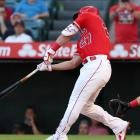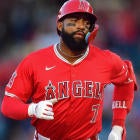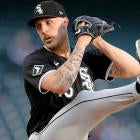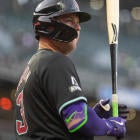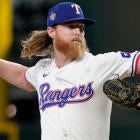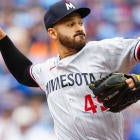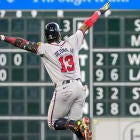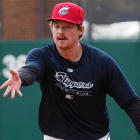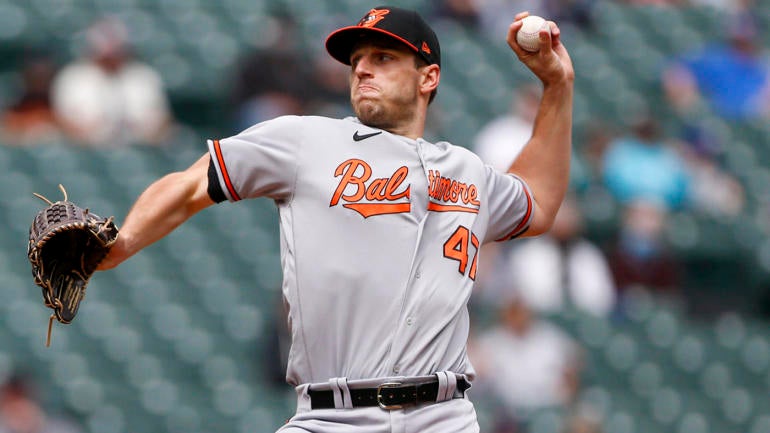
If 2021 is your first season ever playing Fantasy Baseball, let me assure you, this has not been a normal season. Chances are, you probably feel pretty good about your pitching staff, thanks in large part to the emergence of the likes of Trevor Rogers, Carlos Rodon, John Means and other surprisingly effective early breakouts.
On the other hand, you probably don't feel too great about your hitting right now. Christian Yelich, Cody Bellinger, Anthony Rendon, and more stars have been injured while others like Kyle Tucker, Marcell Ozuna, and Francisco Lindor have struggled to do much even when healthy.
It's not just perception: The league has seen a big shift back toward pitching in the early going of the season, and it has fundamentally altered the way we have to approach Fantasy in the early going, and likely for the rest of the season. That has been the dominant storyline in the first month-plus of the season, but that's not the only one. As we get to the middle of May, let's take a look at some of the trends through the first 40 or so days of the season, see how they compare to previous seasons, and what it means for how you should approach your teams moving forward.
The Year of the Pitcher
There are currently 45 pitchers who have thrown at least 30 innings with an ERA below 3.50 and 30 with an ERA below 3.00. At the same point in the league calendar in 2019, 39 pitchers had an ERA below 3.50 and 20 had an ERA below 3.00. And the effect is even more pronounced when you realize only 90 pitchers this season have even thrown 30 innings to date, compared to 119 to the same point.
To illustrate the point even more starkly: If you use last season's Fantasy environment -- which is what the CBS Fantasy standard Roto rankings formula does -- 15 of the top 20 players in Fantasy so far have been pitchers. Put simply, pitchers are dominating the Fantasy game more than they have in a long time in 2021.
That's a result of overall league trends. Offense is down as a whole across the league, with runs per game down to 4.36, compared to 4.65 in 2020 and 4.83 in 2019. And it's not hard to see why: League-wide batting average is down to a record-low .234.
We're seeing a record-high 24.1% strikeout rate, continuing what is now a 16-year trend dating back to 2005. The batting average on balls in play across the league is also down to a 30-year low, at .285. And, while the current HR/9 is still the fifth-highest of all time at 1.18, that's a far cry from the 1.34 and 1.40 marks of the previous two seasons.
Add it all up and we're looking at a league where it's harder to put the ball in play than ever before but teams are also doing a better job of turning balls in play into outs, too. That means offenses are more reliant on walks and homers than ever before -- you can't really count on stringing a couple of hits together when one-quarter of all plate appearances end in strikeouts and one-time seeing-eye singles are now gobbled up by second basemen playing short right field.
Oh, and also, home run rates have fallen from their record highs the previous two seasons. And that's how you get an offensive environment like this.
What does it mean for my Fantasy team?
I think it means this is the perfect time to be selling pitching. It's easier to find, but make no mistake, pitchers are still as fragile as ever. Moving one of those fast-starting pitchers -- Means, Rodon, Rogers, Kevin Gausman, Huascar Ynoa, Danny Duffy, Sean Manaea, Tyler Mahle, etc. -- for offensive help is probably the best way to improve your team, especially if you can get struggling hitters at a discount.
It also means you have to dramatically adjust your expectations and perspective for what your team will look like. In NFC Main Event leagues -- which are 15-team Roto leagues -- the average ERA for all teams leading their individual league in 2019 was 3.57; in 2021, the average team in 10th place in ERA has a 3.63 mark to date.
All of a sudden, a .255 average is actually helping your Fantasy team, while a 4.00 ERA might be dragging you down.
The New Ball
If you're wondering why the game seems to have changed so dramatically, the ball is playing a significant part. MLB introduced new production standards for the baseballs used in 2021, and the effect has been a slightly lighter ball that is easier to throw harder and moves more, comes off the bat harder, but doesn't travel as far when hit. That's led to a higher average exit velocity around the league -- average is 88.9 mph while 39.2% of all batted balls have been hit 95-plus mph, both the highest of the Statcast era -- but more swings and misses and strikeouts and fewer homers.
The strikeout rate is in keeping with long-term trends, but this piece from FanGraphs.com covers the impact on batted balls well. One key finding sums things up pretty well: In April of 2019, batted balls with a launch angle over 30 degrees turned into a home run around 45% of the time and an out around 32% of the time; in April of 2021, they've been outs around 43% of the time and home runs 35% of the time.
What does it mean for my Fantasy team?
For one thing, it's just another sign of how pitching has come to dominate the game in 2021. But it's also worth looking for players who would seem to be most impacted by these changes. I did a search on BaseballSavant.com's Statcast database for hitters with the most batted balls with a launch angle over 30 degrees and an exit velocity below 105 mph, the types of batted balls most impacted by the change in the ball, per that FanGraphs article.
It's an interesting list, with some surprise early contributors like Jed Lowrie, Kyle Seager, and Randal Grichuk, who may be in line for some regression if that approach holds. However, you've also got players like Austin Meadows (third-most), Marcell Ozuna (sixth), Ozzie Albies (10th), and Paul Goldschmidt (15th), whose disappointing starts may not be as much of a fluke as you might hope. Goldschmidt has certainly seemingly had bad luck on such batted balls, with an expected wOBA of .173 compared to an actual mark of .143, the largest gap in the league. However, Ozuna's gap is just .056, while Albies and Meadows have actually outperformed expectations on those batted balls. That may not be a great sign moving forward if they don't adjust their approach.
Speaking of expected stats from Statcast, they've had to adjust their formula for expected stats to account for the new offensive environment, because those stats are based on how similar batted balls have performed historically. If a ball hit 95 mph isn't traveling as far as it used to, an unadjusted system is going to overshoot expectations, and that's what was happening. Those changes went live this week, but you can still see there may be some massaging to do -- the difference between xwOBA and wOBA for the season is .011 points, compared to .001 in 2020.
Statcast's expected tools are an easy way to get an idea of who might be benefitting from a bit of good luck or running into some tough outs, but you still might want to take them with a tiny grain of salt for now. Or, at least don't sell the farm for an "underperformer" just yet.
Another No-Hitter?
Wade Miley just threw a no-hitter last weekend, and the collective reaction from the baseball world was a mix of bemused wonder and something close to exasperation. Worse pitchers than Miley have thrown no-hitters before, of course, but Miley's was the fourth of the season already and the second in a span of three days. Oh, and Sean Manaea took a no-hitter into the eighth inning the same night as Miley's, while Madison Bumgarner threw an unofficial no-hitter in a seven-inning game during a doubleheader a few weeks back, too.
The fact that one of the most exciting events in the game is at risk of seeming routine is a real problem for MLB, and this is a natural result of the changes described in the previous sections -- hits are harder to come by this season.
What does it mean for my Fantasy team?
Well, it's worth noting that two of those no-hitters game against Cleveland, while the other two were against the Rangers and Mariners. Seattle and Cleveland rank in the bottom five of the league in wOBA currently, while the Rangers have the eighth-highest strikeout rate in the league. Nine teams have a strikeout rate over 25%, and that's made for plenty of streaming opportunities. Targeting Miami, Detroit, Milwaukee, Seattle, Baltimore, Cleveland, and the Rockies on the road should continue to be a viable strategy until those teams add some offense.
The Minors Are Back
After a long 2020 with no minor-league baseball, things kicked off last week. There are fewer teams and levels than there used to be, but still, we've got tangible evidence of the development (or lack thereof) of the top prospects in the game for the first time since 2019. Scott White listed the top 14 prospects to stash ahead of their MLB debuts in a recent column, and here's a quick taste of how his top five preseason prospects have fared in the very early going:
- Wander Franco, SS, Rays (5 G, AAA): .304/.385/.696, 2 HR, 1 SB
- MacKenzie Gore (1 GS, AAA): 6.75 ERA, 2.00 WHIP, 3 K, 4 IP
- Jarred Kelenic (4 G, AAA): .444/.500/.778, 2 HR, 2 SB
- Spencer Torkelson (5 G, A+): .158/.292/.211, 0 HR, 1 SB, 11 K
- Julio Rodriguez (6 G, A+): .280/.357/.440, 0 HR, 3 SB
What does it mean for my Fantasy team?
Hopefully, it means we'll start to see some of these top prospects get the call soon. We've seen a few start to trickle in over the last few weeks, but the floodgates will hopefully open up soon. Kelenic and Franco, especially, seemingly have little left to prove down there, and the longer they hit like this, the harder it will be for their teams to justify keeping them down.
Of course, we know they aren't just being kept down because they aren't ready, There are financial reasons for those players to be where they are, and they will likely stay there for a few more weeks to ensure an extra cheap year of club control over their contracts. Still, we're getting close enough to the point where that won't matter that if you're looking to get ahead of the waiver wire, you should definitely go pick up Franco and Kelenic, and consider stashing Jo Adell, Matt Manning, Logan Gilbert, Daulton Jeffries, Jarren Duran, Jeter Downs, and others who could be on the cusp of making an impact if you've got the roster space.
Here's a good rule of thumb if you want to know which top prospects to consider stashing: Once they hit Double-A, every player could be a good two weeks or an injury on the big-league side away from getting the call.














